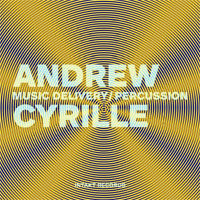Andrew Cyrille • Music Delivery/Percussion
New Orleans pioneer Baby Dodds set a high bar with 1946’s Talking and Drum Solos (on Folkways). His tight, joyous, ever-musical kit workouts pointed the way: he’d isolate particular sounds, effects or techniques from piece to piece, to vary texture and pulsation -- because if you play it all at once, what’s left to play next? Cyrille follows that focal discipline much of the time. “Water Water Water” is propelled by a slow 6/8 beat from Ghana, on cowbell, sparking four- or eight-bar tom-tom breaks. “La Ibkey” is in a halting syncopated 7/4 hi-hat stomp, with bare-handed cross-rhythms over the top -- overdubbed, per Russ Musto’s (commendably informative) notes. Here and elsewhere, spaciousness conveys an unspecified ritual air. Cyrille covers pianist Amina Claudine Myers’ “Jumping in the Sugar Bowl,” an improviser’s vehicle which takes off from the chant Amina sang to open and close it -- “Jumping in the sugar bowl/Jump jump jump” -- with its built-in call-and-response and staccato beat. The drummer works variations on that vamping from the opening bar, chanting the lyric once at the end -- maybe sending you back to the beginning to hear those paraphrases afresh. Cyrille dedicates the album to his Haitian mother, who sang drum rhythms to him as a child, and a retrospective air hangs over the program. “Bernard Albert Wilkinson” is a slow elegy for his best and lifelong friend, a drum set piece building on a little five-note phrase: high tom, low tom, cymbal, snare, bass drum; five pitches, five timbres. There Cyrille honors quietude; among East Coast jazzers he’d been quick to pick up on the 1960s Chicago avant-garde’s pregnant silences. “For Girls Dancing” recalls his years playing for dance classes -- which is how many musicians get paid to practice (and to work on their odd meters, though this tune’s in 4). Dancers inspired the shapes he’d play, he’s said. He revives John Carter’s 1982 “Enter from the East,” a feature for Andrew in the clarinetist’s wondrous octet (and in a later Cyrille trio), an essay on the melodic implications of mallet patterns on well-tuned tom-toms. Most pieces are for full kit, but there are specialty numbers: “Cowbell Ecstasy,” played on an array of same, recalls Henry Threadgill’s hubkaphone (look it up); “Metallic Resonance” is for cymbals and crotales (fat metal discs that chime like a bell), mostly tapped with knitting needles for a pointedly ringing sound. Cyrille has always had a knack for unorthodox techniques: using maracas as drum beaters, or picking snares with his teeth while holding the drum in front of his face, a surreal spectacle. And so on “Tambourine Cocktail” he hits (mostly unspangled) tambourines with other tambourines, which in his hands (and maybe a little overdubbing) can sound oddly like a very dry drum kit. The judiciously cranked-up reverb here increases the one-man-choir effect. As he once said of Wadada Leo Smith’s music: “It’s amazing to me how such concepts evolved from African rhythms.” He could’ve been speaking about his own work. Veteran engineer David Amlen recorded the two-day session
at his Sound on Sound studio in Montclair, NJ, near the drummer’s home. The room
resonance lets drums and cymbals breathe, and the overdubs are admirably discreet, though
there’s at least one arty touch: the slosh of loose hi-hat in the near distance on
“Water Water Water,” making the familiar sock-cymbal sound darkly mysterious. |

 rummer Andrew Cyrille isn’t exactly in
late-career revival -- he never went away -- but his profile is higher than ever, partly
due to a pair of ECM records where his playing is restrained to the point of rarefied. But
he’ll still make the drums speak up. He made his rep in the 1960s working with piano
dynamo Cecil Taylor, but he’d also backed mainstreamers like tenor-sax patriarch
Coleman Hawkins. Cyrille was and is a free player who swings. Music
Delivery/Percussion is the third in his very occasional series of solo percussion
(and voice) albums, after 1969’s What About? (in France’s legendary
BYG/Actuel series) and 1977’s The Loop (from Italy’s Ictus).
rummer Andrew Cyrille isn’t exactly in
late-career revival -- he never went away -- but his profile is higher than ever, partly
due to a pair of ECM records where his playing is restrained to the point of rarefied. But
he’ll still make the drums speak up. He made his rep in the 1960s working with piano
dynamo Cecil Taylor, but he’d also backed mainstreamers like tenor-sax patriarch
Coleman Hawkins. Cyrille was and is a free player who swings. Music
Delivery/Percussion is the third in his very occasional series of solo percussion
(and voice) albums, after 1969’s What About? (in France’s legendary
BYG/Actuel series) and 1977’s The Loop (from Italy’s Ictus).